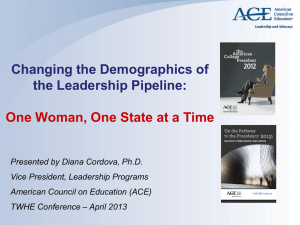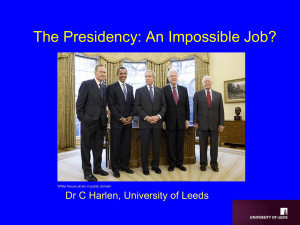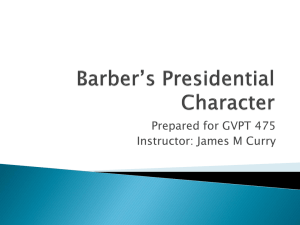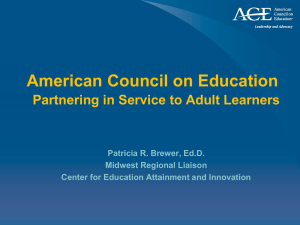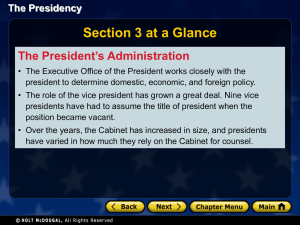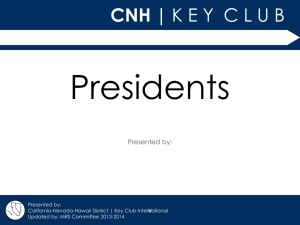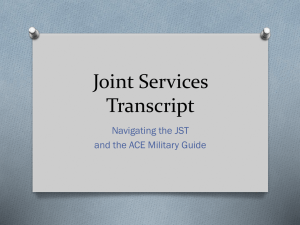Diana Cordova "Moving the Needle Together"
advertisement
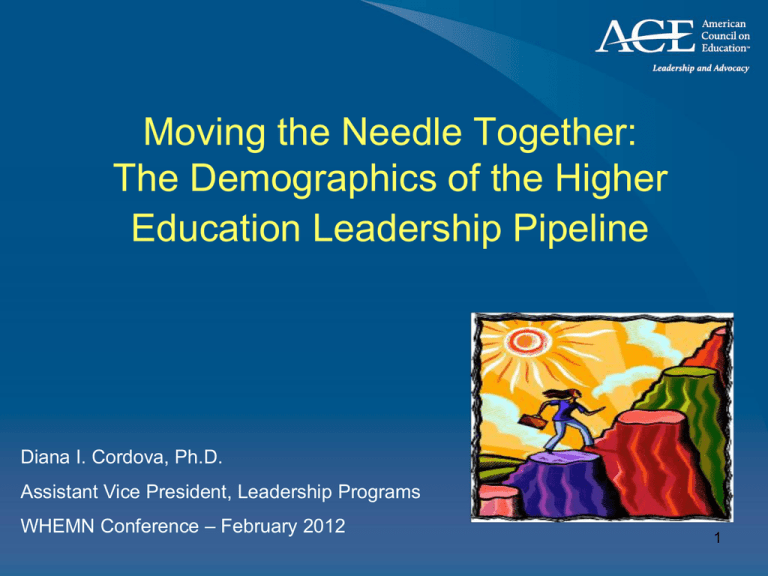
Moving the Needle Together: The Demographics of the Higher Education Leadership Pipeline Diana I. Cordova, Ph.D. Assistant Vice President, Leadership Programs WHEMN Conference – February 2012 1 The American Council on Education (ACE) • Only higher education organization that represents presidents and chancellors of all types of U.S. accredited, degree-granting institutions: community colleges and fouryear institutions, private and public universities, and nonprofit and for-profit colleges. • ACE seeks to provide leadership and a unifying voice on key higher education issues and to influence public policy through advocacy, research, and program initiatives. 2 ACE Leadership Programs • Executive Leadership Group – Institute for New Presidents (coming July 2012) – Advancing to the Presidency – Institute for New Chief Academic Officers • Emerging Leaders Group – ACE Fellows Program – Dept. Chair Workshops (coming summer 2012) • Inclusive Excellence Group – Regional Forums for Mid-Level Women Administrators – National Forums for Senior-Level Women Administrators 3 Key Questions • Why focus now on leadership for the future? • What is the state of the higher education leadership pipeline - for women, in particular? • How are we doing compared to other sectors? 4 Why leadership for the future? • Those who retire (eventually) will need to be “replaced.” • Higher education as an enterprise is expanding. • Higher education is in a high stakes environment, facing serious challenges with no tested solutions. 5 A Growing Higher Education Enterprise 1993 2006 3,632 4,314 Enrollment 14,305,000 18,205,474 Degrees Awarded 2,167,000 3,469,942 Number of Faculty 915,400 1,290,426 Number of Staff 771,900 2,088,661 Number of Institutions Source: Department of Education, IPEDS 6 A High(er) Stakes Future “…this country needs and values the talents of every American. That is why we will provide the support necessary for you to complete college and meet a new goal: by 2020, America will once again have the highest proportion of college graduates in the world.” - President Barack Obama 7 The View from the Top 8 The American College President: 2007 Edition • Sixth national study since 1986 • 2,148 respondents, 70% response rate. • Most comprehensive survey on the characteristics and career paths of college presidents. 9 The Aging of Presidents: 1986 and 2006 100% 90% 13.9 80% 49.3 61 or older 70% 60% 44.4 51 to 60 50% 31 to 50 40% 30% 20% 42.6 41.6 10% 8.1 0% 1986 2006 10 Average Years in the Presidency: 2006 11 Women Presidents by Institution Type: 1986 to 2006 Doctorate-Granting Master's Baccalaureate Associate's Special Focus 35.0 30.0 28.8 25.0 23.2 21.5 20.0 15.0 16.6 13.8 16.1 10.0 10.0 5.0 7.9 6.6 3.8 0.0 1986 1990 1995 1998 2001 2006 12 Progress on Presidential Diversity Has Been Slow Women and People of Color as a Percentage of All Presidents: 1986 and 2006 1986 23% 2006 14% 10% 8% Women Source: ACE. 2007. The American College President: 2007 Edition. People of color 13 Minority Presidents: 1986 and 2006 8 Total Minority 14 5 African American 1986 6 2006 1 1 American Indian 0 Asian American 1 2 Hispanic 5 0.0 5.0 10.0 15.0 14 Minority Presidents: 2006 White African American Hispanic Other 3.9 2.6 90.6 Non-MSI 2.8 41.1 MSI 0 10 20 27.4 30 40 50 22.9 60 70 80 8.5 90 100 15 Marital Status of Presidents: 2006 100% 4 80% 3 10 Never Married 14 Never MarriedReligious Divorced or Separated 60% 40% Widowed 89 63 20% Domestic Partner Married 0% Men Women 16 Family Responsibilities: 2006 100 Any children 91 90 Children 17 or younger 80 68 70 Altered career to care for family 60 50 40 30 20 19 12 15 5 10 0 Men Women 17 Most Recent Position: 2006 Outside Higher Education, 13% Chair/Faculty, 4% President/CEO, 21% Sr. Exec - Other, 3% Sr. Exec Development, 4% Sr. Exec Student Affairs, 4% Sr. Exec Finance/Admin, 8% Other Sr. Exec Academic Affairs, 12% CAO/Provost, 31% 18 Long-Standing Presidents’ Time Demands: Areas Most Likely to Occupy More Time: 2006 Fund raising 78 Accountability/assessment 72 Capital improvement 71 Technology planning 62 Strategic planning 62 Budget/financial mgmt 59 Entrepreneurship 58 Enrollment management 57 Community relations 52 Operating costs 52 0 10 20 30 40 50 60 70 80 19 Time Demands: Areas Most Likely to Occupy Less Time Academic Issues 37.1 Crisis management 23.3 Student life/conduct 21.2 Faculty issues 15.5 Athletics 12.5 Personnel issues 12.3 Risk management/legal issues 11.7 0.0 10.0 20.0 30.0 40.0 50.0 60.0 70.0 80.0 20 Areas Insufficiently Prepared for First Presidency Fund raising 23 Risk management 17 Capital improvement 15 Entrepreneurial ventures 15 Budget Governing board relations Athletics 15 12 12 21 The Contemporary Presidency Slow progress in diversity. Experience matters. Position is: • More complex and time-consuming; • Externally focused; • Driven by the competitive marketplace and the need for revenue. 22 The Pathway Up 23 On the Pathway to the Presidency • Follow-up study to The American College President: 2007 Edition. • First-ever attempt to describe characteristics of senior leaders other than presidents. 24 Research Questions • What is the age profile of senior leaders? (Will the last person out please turn off the lights …) • Are those in position to be the next generation of presidents more diverse than the current group? 25 Methods and Data • Surveyed HR directors at 4,300 regionally accredited, degreegranting institutions. • Used CUPA-HR position taxonomy and ACPS results to identify 35 positions “on the pathway.” • Asked for information in HR databases. • 850 institutions responded with info on about 9,700 positions (20% response rate). • Response rate varied by institution type. Data weighted to reflect national distribution of institutions. 26 Senior Administrators are Younger than Presidents Distribution of Presidents and Other Senior Administrators by Age 19% 29% 61 or older 49% 51 to 60 47% 52% 50 or younger 43% 34% 19% 8% Presidents All Senior Administrators Chief Academic Officers Sources: ACE. 2007. The American College President: 2007 Edition. ACE. 2008. On the Pathway to Presidency: Characteristics of Higher Education’s Senior Leadership. 27 And more likely to be women … Percentage of Presidents and Senior Administrators who are Female 45% 38% 23% Presidents All Senior Administrators Chief Academic Officers Sources: ACE. 2007. The American College President: 2007 Edition. ACE. Sources: ACE. 2007. The American College President: 2007 Edition. ACE. Forthcoming. On the Pathway to Presidency: Characteristics of Higher Education’s Senior Leadership. 28 Senior Administrators No More Likely to be People of Color Percentage of Presidents and Senior Administrators who are People of Color 14% 16% 14% 10% Presidents All Senior Administrators Chief Academic Officers Sources: ACE. 2007. The American College President: 2007 Edition. ACE. 2008. On the Pathway to Presidency: Characteristics of Higher Education’s Senior Leadership. Deans 29 Gender Diversity Among Senior Administrators by Institutional Type 30 Racial/Ethnic Diversity Among Senior Administrators by Institutional Type 31 CAOs’ Presidential Aspirations, by Gender and Race/Ethnicity 25% 33% 28% 35% 34% 48% 28% 23% 24% Intend to seek a presidency Undecided 33% 30% 27% 47% 44% 47% 25% Women Men White African American 33% 36% Asian American Hispanic Source: ACE.2009. The CAO Census: A National Profile of Chief Academic Officers. Do not intend to seek a presidency 32 Select Reasons for Not Aspiring to a Presidency, by Gender 27 23 Don't want to live "in a fishbowl" Want to return to academic work and/or classroom 18 26 27 Time demands of position Too old to be considered Ready to retire Nature of work is unappealing 24 13 Women Men 26 33 31 68 65 33 Steps Taken to Prepare for Presidency: Spoken to a Mentor? 35% 41% 36% 43% 50% 86% 65% 59% 64% 57% No Yes 50% 14% Women Men White African American Asian American Source: ACE.2009. The CAO Census: A National Profile of Chief Academic Officers. Hispanic 34 Steps Taken to Prepare for Presidency: Spoken to Search Consultants? 26% 52% 51% 61% 62% No Yes 93% 45% 48% 49% 39% 38% 7% Women Men White African American Source: ACE.2009. The CAO Census: A National Profile of Chief Academic Officers. Asian American Hispanic 35 How are we doing relative to other sectors? • The White House Project Report: Benchmarking Women’s Leadership – www.thewhitehouseproject.org/documents/Report.pdf • Motivation for the Report – Belief that most people think “Women have made it; it’s no longer an issue.” – Need to document that women are not adequately represented in top leadership positions across sectors. – Need to motivate conversations and actions around this issue. 36 Percent of Women in Leadership Positions by Sector 50% 40% 30% 23% 20% 22% 16% 16% 21% 18% 11% 17% 15% 21% 18% 10% 0% Source: The White House Project analysis 37 38 Sources: Catalyst 2005, 2006 (a), (b), 2007(b); Catalyst 2008 (a), (b); Catalyst 2009 (a); Daily et al. 1999 Source: The Face of Corporate Leadership by Toni Wolfman in the New England Journal of Public Policy, Spring 2007 39 40 Source: Association of Governing Boards of Universities and Colleges (AGB) Why Women? The Business Case • Catalyst Report: Fortune 500 firms with higher percentages of women corporate officers experienced a 35% higher return on equity and a 34% higher return to shareholders. • Ernst and Young Report: Diverse groups outperform homogenous groups even if the members of the homogenous group are more capable. 41 For Discussion • What are some of the major factors that stand in the way of women’s advancement to top leadership positions in higher education? • How can we overcome some of these barriers? How can ACE and the State Networks more effectively support, advance and sustain women leaders? 42 Diana I. Córdova Assistant Vice President for Leadership Programs dcordova@acenet.edu (202) 939-9481 43
